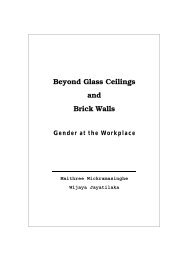SETP No. 14 The Economic Value of Incremental Employment in the ...
SETP No. 14 The Economic Value of Incremental Employment in the ...
SETP No. 14 The Economic Value of Incremental Employment in the ...
Create successful ePaper yourself
Turn your PDF publications into a flip-book with our unique Google optimized e-Paper software.
3 A Labour Focussed Pr<strong>of</strong>ile <strong>of</strong> <strong>the</strong> Construction Industry<br />
3.1 This section <strong>of</strong> <strong>the</strong> report focuses on <strong>the</strong> construction <strong>in</strong>dustry with <strong>the</strong> objective<br />
<strong>of</strong> determ<strong>in</strong><strong>in</strong>g a pr<strong>of</strong>ile <strong>of</strong> actual salaries and wages. This is clearly <strong>the</strong> start<strong>in</strong>g<br />
po<strong>in</strong>t <strong>of</strong> <strong>the</strong> study as wages determ<strong>in</strong>e <strong>the</strong> cost differential between labour-based<br />
and equipment-based construction and <strong>the</strong> magnitude <strong>of</strong> <strong>the</strong> associated macro<br />
economic impact.<br />
3.2 Depth is given to this pr<strong>of</strong>ile by identify<strong>in</strong>g wage differentials across <strong>the</strong> country,<br />
by occupation and by size <strong>of</strong> firm and by compar<strong>in</strong>g construction wages to those<br />
<strong>in</strong> manufactur<strong>in</strong>g.<br />
3.3 It will be shown that <strong>the</strong> construction <strong>in</strong>dustry is a small and (currently) decl<strong>in</strong><strong>in</strong>g<br />
<strong>in</strong>dustry. <strong>No</strong>t only has output fallen but so too have real wages. Some types <strong>of</strong><br />
wage measures were easy to determ<strong>in</strong>e. O<strong>the</strong>r proved to be less so. Determ<strong>in</strong><strong>in</strong>g<br />
wages by occupation by location proved particularly difficult.<br />
Contribution to Gross Domestic Product<br />
3.4 <strong>The</strong> construction <strong>in</strong>dustry plays a small role <strong>in</strong> <strong>the</strong> generation <strong>of</strong> overall economic<br />
activity. In addition this contribution has decl<strong>in</strong>ed consistently s<strong>in</strong>ce <strong>the</strong> early<br />
1980s. (See Figures 3.1 and Table 3.1) In 1981 <strong>the</strong> construction <strong>in</strong>dustry<br />
generated GDP to <strong>the</strong> value <strong>of</strong> R10 billion (1990 values). This was large enough<br />
to contribute 4.3% to overall GDP. By 1998 <strong>the</strong> real value <strong>of</strong> contribution to GDP<br />
had decreased to R7.6 billion and contributed only 2.7% to overall GDP.<br />
Figure 3-1<br />
Product<br />
by K<strong>in</strong>d <strong>of</strong><br />
<strong>Economic</strong><br />
Sectoral composition <strong>of</strong> South African GDP<br />
300,000<br />
250,000<br />
Rm constant 1990 values<br />
200,000<br />
150,000<br />
100,000<br />
General government<br />
Community services<br />
F<strong>in</strong>ancial services<br />
Transport & communication<br />
Trade<br />
Construction<br />
Electicity, gas & water<br />
Manufactur<strong>in</strong>g<br />
M<strong>in</strong><strong>in</strong>g<br />
Agriculture<br />
50,000<br />
-<br />
1980 1981 1982 1983 1984 1985 1986 1987 1988 1989 1990 1991 1992 1993 1994 1995 1996 1997 1998<br />
4
















